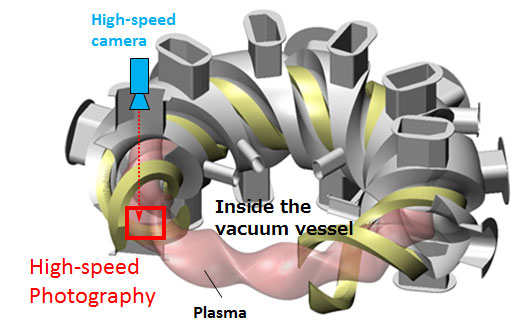HOME > Research Activities > Research Updates >
In the Large Helical Device (LHD) we watch and measure plasmas using high-speed cameras. Compared to video cameras sold in the market that take thirty images per second, high-speed cameras can take more than 100,000 images in one second, at an extraordinary speed. Regarding the various phenomena in an LHD plasma as photographed by a high-speed camera, we introduced this topic in a Research Report published in 2013 (see back number 204). Here, we will introduce both new diagnostics achievements since that time and research results from the most recent numerical simulation analyses utilizing super computers.
In the LHD, we generate a magnetic field chamber in the vacuum vessel and confine a high-temperature plasma there. In the vacuum vessel are generated fine dusts which sometimes scatter near the plasma’s last closed surface. These dusts are primarily made of iron (the primary component of stainless steel which is a wall material in the vacuum vessel) and carbon. Because light is generated when dusts enter a plasma, it is observed as a bright spot on the screen of a high-speed camera. This phenomenon is like a shooting star that plunges into the atmosphere due to the earth’s gravity.
When many dusts enter a plasma, the plasma temperature falls and it is quenched. In an LHD experiment conducted in 2013 we succeeded in maintaining a plasma of 23,000,000 degrees for the long period of forty-eight minutes. While photographing that plasma with a high-speed camera, dust suddenly was generated from the wall surface of the magnetic field chamber. We were able to capture the plasma’s disappearance due to the entry of dust into that plasma. From the generation of dust to the disappearance of the plasma took less than 0.2 seconds. After the conclusion of the experiment, when we confirmed the location where the dust had been generated, dusts composed a layer called a “mixed sediment layer” (which is composed of mixed layers of carbon and iron). We learned that these layers were generated by exfoliation (For details, see back number 273).
Further, until now we were taking photographs from a single direction using a high-speed camera. However, recently, we have begun taking photographs from two separate directions (stereovision). Thus we have become able to follow in detail the three-dimensional movements of dusts, which had been difficult with unidirectional photography. Resulting from these diagnostics, we learned that most dusts are found in edge plasma, and that dusts are moving while being accelerated following the plasma flow. However, we also clarified that a very small number of dusts move in directions that are completely unrelated to the plasma flow. We discovered a new research issue in the clarification of the cause of this unusual movement and its physical mechanism.
In order to investigate the movement of dust, we initiated numerical simulation analyses using the supercomputer (Plasma Simulator) at the National Institute for Fusion Science. In the computer we constructed a virtual three-dimensional model that simulated an LHD plasma and the vacuum vessel. A result from conducting a simulation of discharging dusts composed of carbon and iron in the direction of the plasma was that in the cases in which dusts were few in number depending upon the effect of the edge plasma flow, we learned that dust is expelled to outside the plasma. Conversely, when the number of dusts increases, the plasma temperature falls due to the ionization of dusts, carbon and iron atoms, in the edge plasma. And it has become clear that those ions enter the interior of the plasma.
Such generation of dusts during long-time maintenance of a plasma is a phenomenon that is thought to be found not only in the LHD. It is also expected to be likely to occur in the International Thermonuclear Experimental Reactor (ITER), currently under construction in France. From both imaging analysis of plasmas photographed with a high-speed camera and numerical simulation analysis using a supercomputer, we will investigate in still further detail the influence of dust movements and their influences upon plasma, and we will continue to contribute to extending further the long-time maintenance of plasma.


In a long-time plasma maintenance experiment, we took photographs using a high-speed camera from an upper port (window) of the conditions as a plasma terminates. Images one through three show the changing condition of the plasma through a series of photographs taken at that time (See the images above). In the lower right of the image (the inner side of the doughnut-shaped vacuum vessel) numerous bright points (dusts) appear. These bright points move toward the upper left (the side on which the plasma is found), and their rapid movement was measured (①). Subsequently, together with the invasion of these dusts into the plasma, the number of dusts increased and the points changed into a thick and bright line (②). This bright line rapidly becomes thicker, and together with brightening the entire plasma it reduces the size of the plasma. Finally, the condition in which the plasma is terminated (③) is observed. These phenomena occur in less than 0.2 second.
